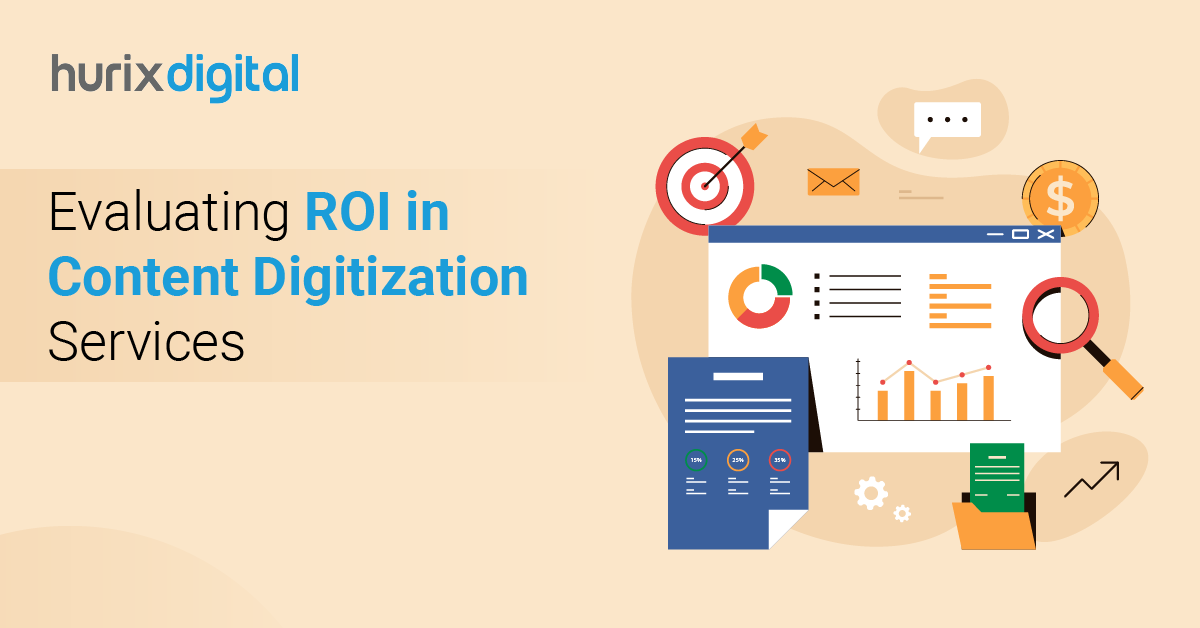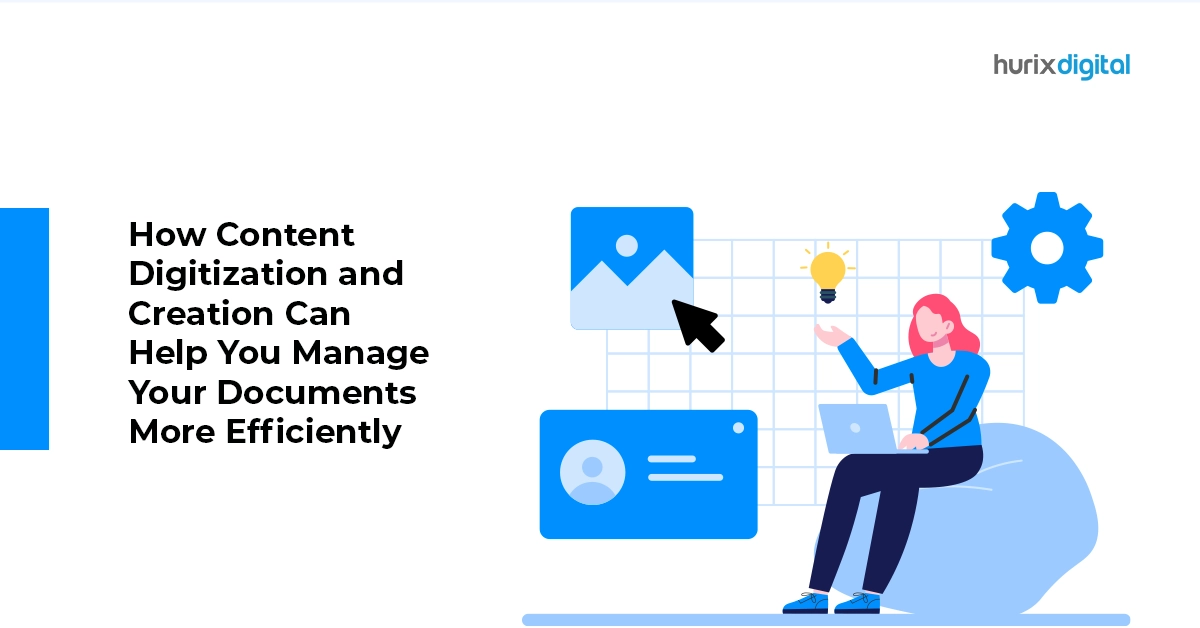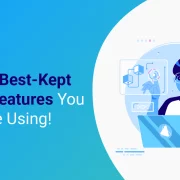
Evaluating ROI in Content Digitization Services
Summary
This article discusses ROI assessment methods for project managers in content digitization, detailing financial, productivity, compliance, and search efficiency measurement strategies and tools for optimization.
Project and production managers play a crucial role in transforming traditional content into dynamic digital assets. To ensure these efforts are truly effective, it is essential to demonstrate tangible cost savings through ROI, which can significantly enhance productivity.
Tracking ROI in content digitization involves more than just analyzing numbers; it helps uncover hidden efficiencies and identify opportunities for further optimization.
Organizations can leverage potential savings from reduced retrieval times or improved compliance management for strategic advantages by assessing these insights. This guide will explore various methods to measure ROI in content digitization effectively. Read on!
Table of Contents:
- 4 Strategies to Assess Content Digitization ROI
- Tools to Measure ROI of Content Digitization Initiatives
- Final Words
4 Strategies to Assess Content Digitization ROI
Digital transformation is rapidly taking over and businesses are spending tons of money to effectively inculcate and benefit from digitization. Globally, this expenditure will reach $3.4 trillion by 2026. When so much money is being spent on digitization, it becomes even more necessary to track the returns.
Here are five strategies that will help project managers effectively assess the return on investment in content digitization:
1. Measuring Financial Savings from Digitization
Quantifying cost savings is crucial for project managers assessing content digitization ROI. A practical method involves conducting a detailed cost-benefit analysis of digitization (CBAD).
The first step is to identify all the costs associated with digitization. These include initial software and hardware investments, training, and ongoing maintenance. Simultaneously, you must also estimate savings from reduced paper usage, decreased storage needs, and time saved on manual processes.
Here’s an example to help you better understand:
- Calculate the yearly expenditure on paper, printing, and storage before digitization. Post-implementation, track reductions in these costs.
- Utilize productivity metrics like time spent searching for documents pre- and post-digitization.
- Multiply saved hours by hourly wages to quantify monetary gains.
Next, consider intangible benefits such as better data accessibility and reduced error rates and translate them into potential cost savings. Finally, compare total costs to savings over a defined period to determine the net ROI from cost savings from content digitization. As a result, this method provides project managers with a clear financial picture and justification for digitization initiatives.
2. Evaluating Compliance and Risk Reduction Benefits
The next strategy for demonstrating ROI for digitized content would be to implement and quantify compliance and risk management aspects. In short, you have to assess the reduction in compliance violations and associated penalties post-digitization.
- Define the regulatory requirements for your business and your industry and the costs associated with non-compliance typically seen in your field.
- Implement digitization solutions to reduce the risk of breaches and non-compliance incidents.
- Measure the frequency and severity of compliance issues before and after implementation.
- Track metrics such as turnaround times for compliance audits and incident response.
- Quantify savings by estimating potential fines, legal fees, and reputational damage averted through improved compliance.
3. Assessing Productivity and Accessibility Gains
Content digitization improves accessibility by eliminating physical barriers to information. Again, you can assess ROI on content digitization by quantifying the time savings and efficiency gains resulting from easy and organized access to digital content.
- Project managers can measure the reduction in time spent on document retrieval and information processing tasks.
- Track improvements in project turnaround times and customer response rates facilitated by quicker access to digitized resources.
- Gather feedback from users on how digitization has improved their workflow efficiency and collaboration.
- Quantify these productivity gains by calculating the hours saved multiplied by the average labor cost.
At last, summarize the cumulative time and cost savings over a specified period to determine the ROI specifically attributed to improving accessibility and productivity through content digitization.
4. Analyzing Improvements in Search Efficiency
Digital transformation also includes implementing digitization tools that enhance search capabilities through metadata tagging, keyword indexing, and advanced search algorithms.
As a project manager, you have to measure returns on digitization initiatives that improve the searchability of your content to get a clearer idea about content digitization ROI.
To do so:
- Track metrics such as search query response times and the percentage increase in successful searches post-digitization.
- Calculate time saved per search and multiply by the number of searches conducted monthly or annually.
- Consider qualitative factors such as reduced frustration and improved decision-making speed due to quicker access to relevant information.
- Summarize the tangible time savings and qualitative improvements to quantify the overall ROI.
Additionally, production managers can further enhance their understanding of ROI by integrating these strategies with comprehensive analytics tools and feedback mechanisms to continually refine and optimize content digitization efforts.
Also Read: 7 Educational Content Development Strategies for Higher-ed Institutions
Tools to Measure ROI of Content Digitization Initiatives
Here are some tools and resources that project managers can utilize to measure the return on investment of your content digitization efforts:
| ROI Measurement Tool | Description |
| Cost-Benefit Analysis | A structured approach to compare the costs incurred with the benefits gained from digitization. It helps in quantifying financial gains such as reduced operational costs and increased revenue opportunities. |
| Total Cost of Ownership Calculators | Calculate the total cost of ownership over the lifecycle of digitization initiatives. This includes initial investments, operational costs, and maintenance expenses versus the benefits accrued. |
| Surveys and Feedback Mechanisms | Gather qualitative data through surveys and feedback loops to understand user satisfaction, productivity improvements, and areas needing further optimization. |
Production managers should leverage these tools to ensure that the value derived from content digitization is not only measured but also maximized.
By systematically applying these strategies and tools, they can provide a comprehensive analysis of the ROI, support informed decision-making, and drive ongoing improvements in digital asset management.
Also Read: The Future of Content Digitization – AI, Machine Learning, and Beyond!
Final Words
With significant investments directed toward digitization efforts, measuring ROI becomes paramount. It allows organizations to quantify the financial benefits, efficiency improvements, and enhanced productivity stemming from these initiatives.
As a project manager, you have to establish clear, specific KPIs that align with your organizational goals. These KPIs will help you assess the content digitization ROI extensively.
Hurix Digital specializes in digital content transformation, offering production, prepress, accessibility solutions, and subject matter expert services. We convert content into digital formats, optimize layouts, guarantee accessibility compliance, and provide expert insights for impactful digital experiences.
Book a discovery call today to learn more!

Vice President – Digital Content Transformation. He is PMP, CSM, and CPACC certified and has 20+ years of experience in Project Management, Delivery Management, and managing the Offshore Development Centre (ODC).








